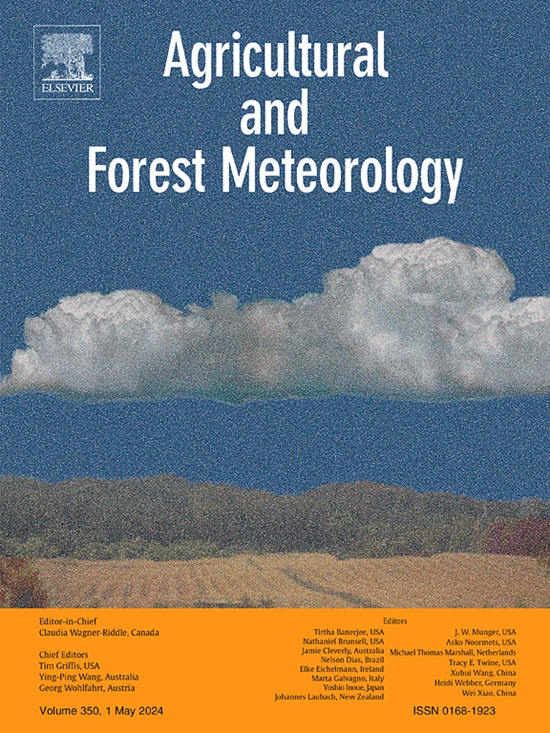巴西中部灌溉用水的降水循环利用
IF 5.6
1区 农林科学
Q1 AGRONOMY
引用次数: 0
摘要
巴西大约一半的用水需求用于灌溉,在过去的几十年里,巴西中部的灌溉规模大大扩大。本研究旨在估计灌溉对区域气候系统的反馈作用。更具体地说,我们估计了巴西中部四个灌区用于灌溉的取水量在当地和顺风地区的再沉淀量。首先,我们使用卫星数据产品描述了2001-2018年巴西中部四个灌区的灌溉活动特征,并估计了河流的取水量。其次,我们使用再降水数据集来估计这些灌区的蒸散发的命运。然后,我们区分了多少水分回收来自降雨,多少来自灌溉。最后,我们计算了当地和下风地区有多少水分被回收利用。我们的研究结果表明,随着中心支点数量、灌溉面积、灌溉深度和灌溉用水量的增加,灌溉活动有所扩大。我们还观察到,由于大气中存在额外的水分,这些年来降水再循环的增加,其中一部分落在发生灌溉的同一盆地(约4% - 8%),另一部分流到大陆的其他地区,主要流到Paraná-Prata盆地。平均而言,从巴西中部河流中抽取的用于灌溉的水有一半在南美洲重新沉淀。我们的研究表明,除了增加作物产量外,灌溉还可以促进当地和南美洲其他地区的降水。本文章由计算机程序翻译,如有差异,请以英文原文为准。
Precipitation recycling of water used for irrigation in Central Brazil
About half of Brazil’s water demand is for irrigation, which has expanded greatly in Central Brazil in the last several decades. This study aims to estimate the feedback of irrigation on the regional climate system. More specifically, we estimate the amount of water withdrawals for irrigation in four irrigation zones in Central Brazil reprecipitate locally and in downwind regions. First, we used satellite data products to characterize the irrigation activity in four irrigation zones in Central Brazil during 2001–2018 and to estimate the water withdrawals from the rivers. Second, we used a reprecipitation dataset to estimate the fate of evapotranspiration from these irrigation areas. Then, we separated how much moisture recycling comes from rainfall and how much comes from irrigation. Finally, we calculated how much of the moisture was recycled locally and in downwind regions. Our results show an expansion of irrigation activity, with an increase in the number of center pivots, irrigation area, irrigation depth, and water used for irrigation. We also observed an increase in precipitation recycling over these years due to the presence of additional moisture in the atmosphere, with part of it falling in the same basin where irrigation occurred (about 4 %-8 %) and the other part flowing to other regions of the continent, mainly to the Paraná-Prata basin. On average, half of the water removed from Central Brazilian rivers for irrigation reprecipitates in South America. Our study demonstrates that, in addition to increasing crop production, irrigation can contribute to precipitation locally and in other parts of South America.
求助全文
通过发布文献求助,成功后即可免费获取论文全文。
去求助
来源期刊
CiteScore
10.30
自引率
9.70%
发文量
415
审稿时长
69 days
期刊介绍:
Agricultural and Forest Meteorology is an international journal for the publication of original articles and reviews on the inter-relationship between meteorology, agriculture, forestry, and natural ecosystems. Emphasis is on basic and applied scientific research relevant to practical problems in the field of plant and soil sciences, ecology and biogeochemistry as affected by weather as well as climate variability and change. Theoretical models should be tested against experimental data. Articles must appeal to an international audience. Special issues devoted to single topics are also published.
Typical topics include canopy micrometeorology (e.g. canopy radiation transfer, turbulence near the ground, evapotranspiration, energy balance, fluxes of trace gases), micrometeorological instrumentation (e.g., sensors for trace gases, flux measurement instruments, radiation measurement techniques), aerobiology (e.g. the dispersion of pollen, spores, insects and pesticides), biometeorology (e.g. the effect of weather and climate on plant distribution, crop yield, water-use efficiency, and plant phenology), forest-fire/weather interactions, and feedbacks from vegetation to weather and the climate system.

 求助内容:
求助内容: 应助结果提醒方式:
应助结果提醒方式:


